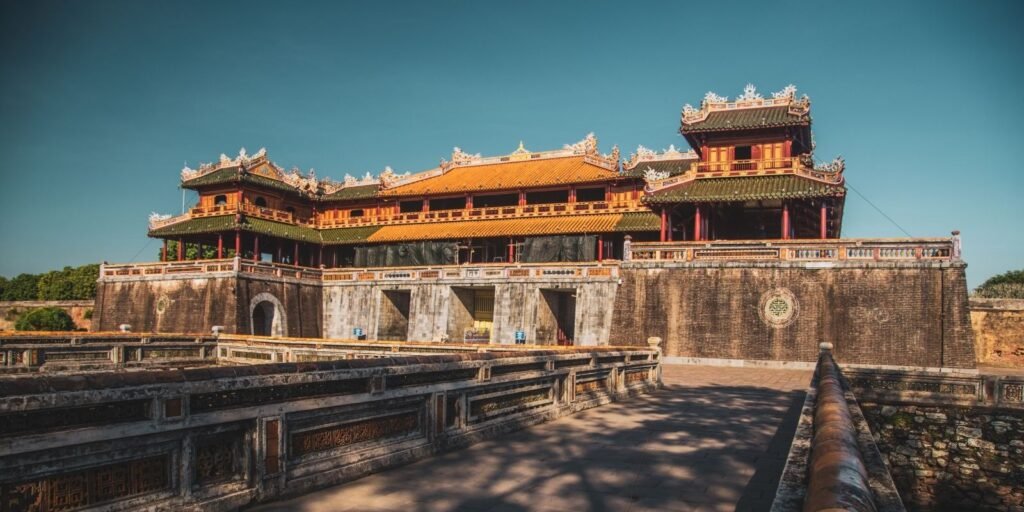- Halong Bay
With a total area of about 1,553 square kilometers, including almost 2,000 large and small rocky islands, caves and beautiful beaches, it was recognized as a UNESCO World Heritage Site in 1994. This stunning and breathtaking bay is beautiful for its emerald water and limestone rocks that arise naturally from the sea. Imagine sailing through this magical landscape, surrounded by towering cliffs and countless islands. It is a truly unforgettable experience that will leave you speechless for its enchanting beauty. On November 29, 2000, Ha Long Bay was further recognized as a World Natural Heritage site for its geological and geomorphological values. Besides, September 16, 2023 (Vietnam time), Ha Long Bay in Quang Ninh Province and the Cat Ba Archipelago in Hai Phong City were officially recognized by UNESCO as a World Natural Heritage site.
Year of recognition: 1994, 2000, 2023
- The Hue Monument Complex
The Hue Monument Complex was declared a World Cultural Heritage by UNESCO thanks to its ancient ruins, royal tombs and imperial citadel, which significantly represent the history of the Nguyen Dynasty. Lose yourself in the grandeur of the citadel, once home to the emperors and their courts. Come and visit the Hue Citadel and discover the history of the last feudal dynasty of Vietnam.
Year of recognition: 1993
- Hoian Ancient Town
Hoi An ancient town with architectural and cultural highlights of the combination of culture over the centuries, perfectly preserved since the 16th century has been recognized by UNESCO as a world cultural heritage twice in 1999 and 2023 for its well-preserved traditional urban architecture. Hoi An represents an exceptional example of a well-preserved town that reflects the cultural and historical fusion of the different communities that have resided there over the centuries. This charming town is famous for its well-preserved architecture, narrow streets and colorful lanterns that illuminate the night. As you wander around the historic district, you will feel like you have entered a fairy tale.
Year of recognition: 1999 & 2023
- My Son Sanctuary
My Son Sanctuary was built around the 4th century, it is an architectural complex of extremely unique Cham temples. My Son Sanctuary was selected by UNESCO in 1995 as one of the world heritage sites for its cultural and historical value. This archaeological site contains the ruins of an ancient city of the Champa Kingdom. The sacred towers and temples of My Son represent the unique outstanding example of the religious architecture of the time, reflecting the spirituality and cultural importance of the Cham civilization.
Year of recognition: 1995
- Phong Nha Ke Bang National Park
Phong Nha Ke Bang National Park is located in the northern Truong Son mountain range in Quang Binh Province and is one of the two largest limestone mountain areas in the world, covering an area of over 200,000 hectares. The site has been recognized by UNESCO as a natural world heritage site twice in 2003 and 2015 for its exceptional geological and biological diversity. The area is home to one of the largest and oldest karst areas in the world, with spectacular cave formations and unique karst landscapes.
Year of recognition: 2003 & 2015
- Thang Long Citadel
The Imperial Citadel of Thang Long – Hanoi is a testimony to the exchange and reception of human culture and civilization, especially Buddhism and Confucianism. At the same time, it is a symbol of the victory of the struggle against colonialism and national independence. Therefore, in 2010, the Imperial Citadel of Thang Long was recognized by UNESCO as one of the world’s cultural heritages.
Year of recognition: 2010
- Citadel of the Ho Dynasty
The Ho Dynasty Citadel was the capital of Vietnam between 1398 and 1407, it is an ancient structure of great cultural and architectural value. This is one of the few remaining stone citadels in the world. On June 27, 2011, the Ho Dynasty Citadel was recognized by UNESCO as a world cultural heritage. It is recognized under two criteria, including historical criteria and unique architectural criteria.
Year of recognition: 2011
- Trang An Landscape Complex
Trang An is located in Ninh Binh Province, a region in northern Vietnam. The heritage site covers an area of 6,226 hectares, mainly wetlands and rice paddies. In 2014, Trang An was listed as a UNESCO World Cultural and Natural Heritage Site for its outstanding natural beauty and significant cultural value, and is the first mixed heritage site in Vietnam and Southeast Asia. The area is characterized by a landscape of limestone mountains, meandering rivers and spectacular caves. This site reflects the connection between the natural environment and human activities, with evidence of historical human settlements and important religious sites.
Year of recognition: 2014










